
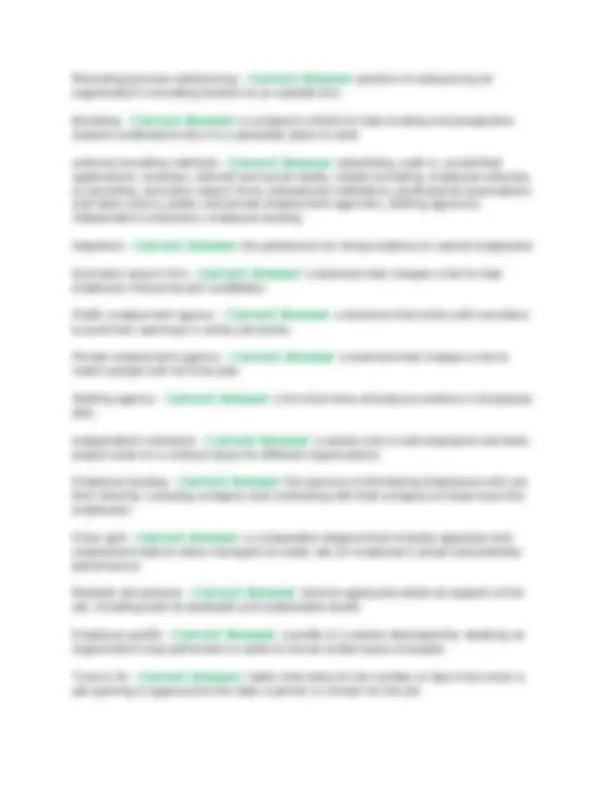
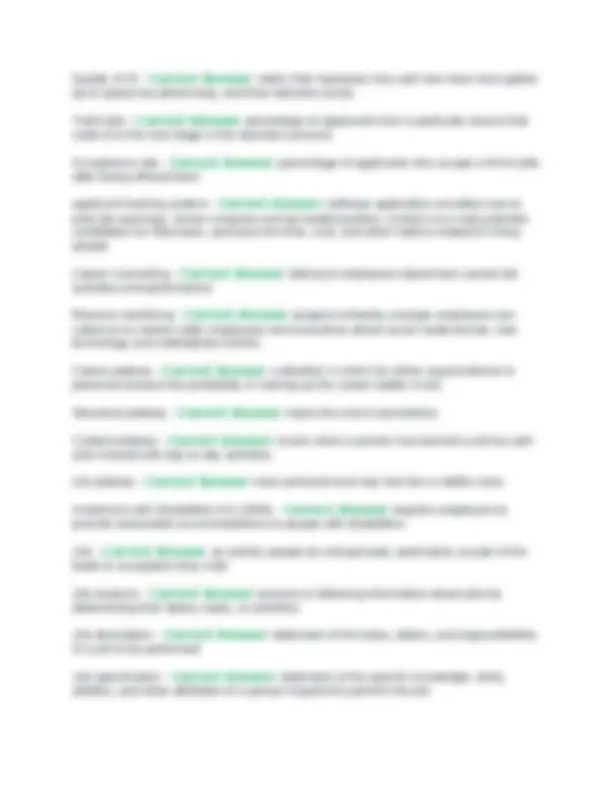
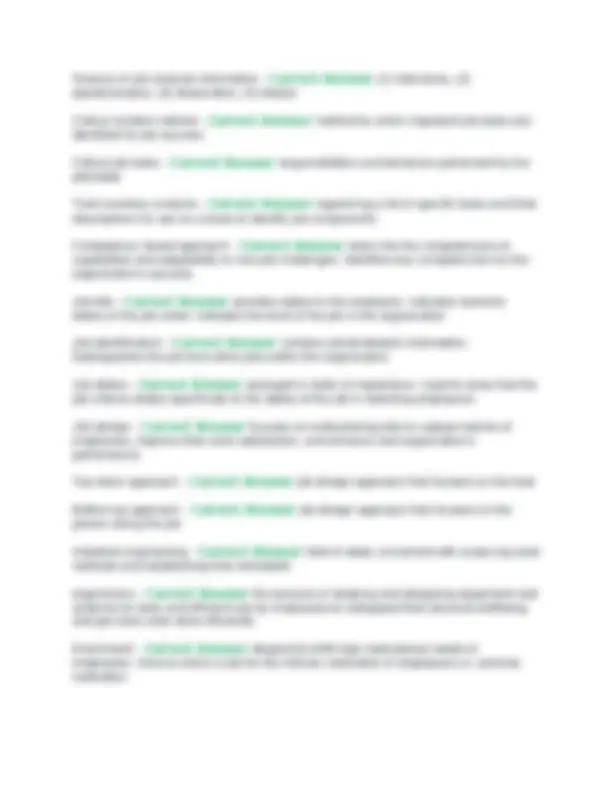
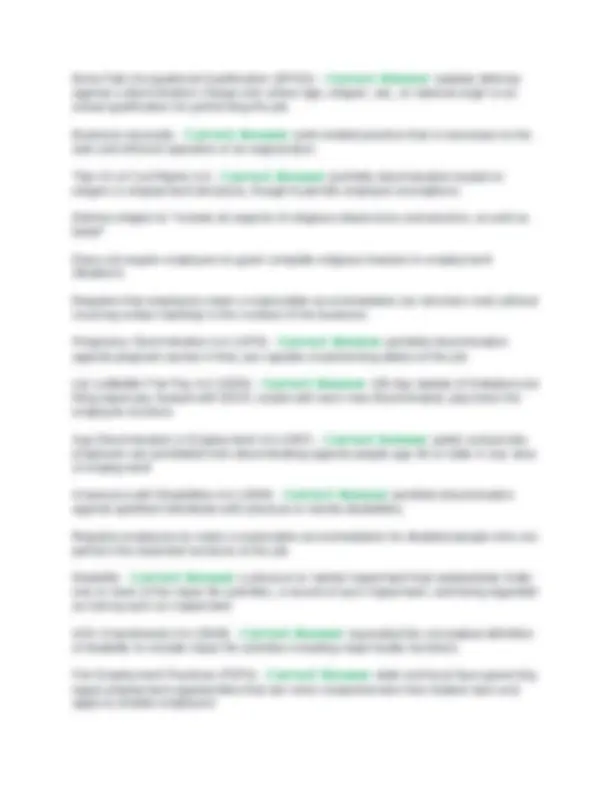
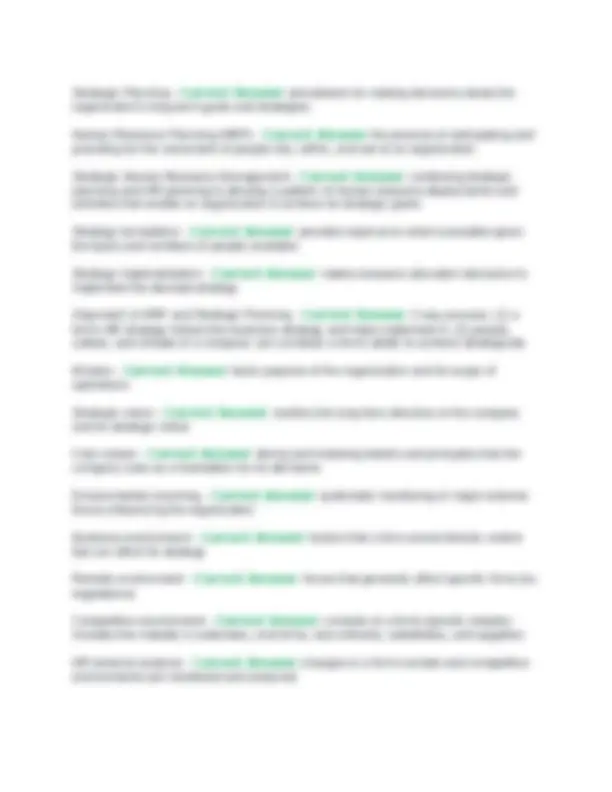
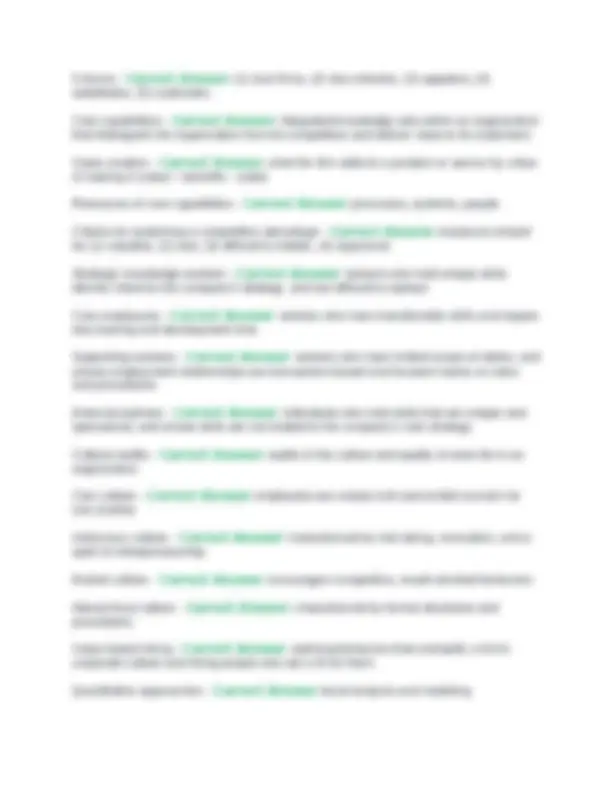


Study with the several resources on Docsity

Earn points by helping other students or get them with a premium plan


Prepare for your exams
Study with the several resources on Docsity

Earn points to download
Earn points by helping other students or get them with a premium plan
Community
Ask the community for help and clear up your study doubts
Discover the best universities in your country according to Docsity users
Free resources
Download our free guides on studying techniques, anxiety management strategies, and thesis advice from Docsity tutors
Human Resource Management Examination alongside the correct responses to the question
Typology: Exams
1 / 12

This page cannot be seen from the preview
Don't miss anything!







Human Resource Management - Correct Answer the process of managing human talent to achieve and organization's objectives Human Capital - Correct Answer knowledge, skills, and capabilities of individuals that have economic value to an organization Downsizing - Correct Answer planned elimination of jobs Outsourcing - Correct Answer hiring outside the company to perform processes previously done within the firm Offshoring - Correct Answer sending jobs to other countries Issues in HRM due to globalization - Correct Answer (1) better informed employees who are willing to pursue global job opportunities, (2) gauging the knowledge and skill base of workers worldwide, (3) relocating and training foreign managers abroad to direct the efforts of an international workforce Corporate social responsibility - Correct Answer responsibility of the firm to act in the best interest of the people and communities affected by its activities Sustainability - Correct Answer ability to produce a good or service without damaging the environment or depleting a resource Collaborative software - Correct Answer allows workers to interface and share information with one another electronically Knowledge workers - Correct Answer workers whose responsibilities extend beyond the physical execution of work to include planning, decision-making, and problem solving Human Resource Information System (HRIS) - Correct Answer provides current and accurate data for purposes of control and decision-making Productivity - Correct Answer output gained from a fixed amount of inputs
Managing the size of the workforce - Correct Answer size should match the firm's demand requirements, strategic decision, and competition Nearshoring - Correct Answer bringing jobs closer to domestic countries Home shoring - Correct Answer outsourcing work to domestic workers who work out of their homes Furloughing - Correct Answer the practice of requiring employees to take time off for either no pay or reduced pay Employee leasing - Correct Answer dismissing employees who are then hired by a leasing company and contracting with that company to lease back the employees Silent generation - Correct Answer generation from 1900- Baby boomers - Correct Answer generation from 1946- Generation X - Correct Answer generation from 1965- Millennials - Correct Answer generation from 1981- Nexters - Correct Answer generation from 2001 and after Employee engagement - Correct Answer the extent to which employees are enthused about their work and committed to it Line Managers - Correct Answer non-HR managers who are responsible for overseeing the work of other employees Responsibilities of HR managers - Correct Answer strategic advice and counsel, service, policy formulation and implementation, employee advocacy Human Resource Competency Model - Correct Answer Business Mastery, HR Mastery, Personal Credibility Elements of a recruiting strategy - Correct Answer Brand, Focus, Location, Method, Timing, Decision Internal labor markets - Correct Answer markets in which workers are hired into entry-level jobs. Higher-level jobs are filled from within Timing - Correct Answer Recruiting plans are to be based on a firm's business strategies, company talent, and future needs
Quality of fill - Correct Answer metric that measures how well new hires have gotten up to speed are performing, and their retention levels Yield ratio - Correct Answer percentage of applicants from a particular source that make it to the next stage in the selection process Acceptance rate - Correct Answer percentage of applicants who accept a firm's jobs after being offered them applicant tracking system - Correct Answer software application recruiters use to post job openings, screen resumes and up-loaded profiles, contact vis e-mail potential candidates for interviews, and track the time, cost, and other metrics related to hiring people Career counseling - Correct Answer talking to employees about their current job activities and performance Reverse mentoring - Correct Answer program whereby younger employees are called on to mentor older employees and executives about social media trends, new technology and marketplace trends Career plateau - Correct Answer a situation in which for either organizational or personal reasons the probability of moving up the career ladder is low Structural plateau - Correct Answer marks the end of promotions Content plateau - Correct Answer occurs when a person has learned a job too well and is bored with day to day activities Life plateau - Correct Answer more profound and may feel like a midlife crisis Americans with Disabilities Act (1990) - Correct Answer requires employers to provide reasonable accommodations to people with disabilities Job - Correct Answer an activity people do and get paid, particularly as part of the trade or occupation they hold Job analysis - Correct Answer process of obtaining information about jobs by determining their duties, tasks, or activities Job description - Correct Answer statement of the tasks, duties, and responsibilities of a job to be performed Job specification - Correct Answer statement of the specific knowledge, skills, abilities, and other attributes of a person required to perform the job
Sources of job analysis information - Correct Answer (1) interviews, (2) questionnaires, (3) observation, (4) diaries Critical incident method - Correct Answer method by which important job tasks are identified for job success Critical job tasks - Correct Answer responsibilities and behaviors performed by the jobholder Task inventory analysis - Correct Answer organizing a list of specific tasks and their descriptions for use as a basis to identify job components Competency based approach - Correct Answer looks into the competencies or capabilities and adaptability to new job challenges. Identifies key competencies for the organization's success Job title - Correct Answer provides status to the employee. Indicates what the duties of the job entail. Indicates the level of the job in the organization Job identification - Correct Answer contains administration information. Distinguishes the job from other jobs within the organization Job duties - Correct Answer arranged in order of importance. Used to show that the job criteria relates specifically to the duties of the job in selecting employees Job design - Correct Answer focuses on restructuring jobs to capture talents of employees, improve their work satisfaction, and enhance and organization's performance Top down approach - Correct Answer job design approach that focuses on the task Bottom up approach - Correct Answer job design approach that focuses on the person doing the job Industrial engineering - Correct Answer field of study concerned with analyzing work methods and establishing time standards ergonomics - Correct Answer the process of studying and designing equipment and systems for easy and efficient use by employees to safeguard their physical wellbeing and get more work done efficiently Enrichment - Correct Answer deigned to fulfill high motivational needs of employees. Aims to enrich a job for the intrinsic motivation of employees vs. extrinsic motivation
Project team - Correct Answer a group formed specifically to design a new product or service. The members are assigned by their managers on the basis of their ability to contribute to the team's success Self-directed team - Correct Answer groups of highly trained individuals performing a set of independent job tasks within a natural work unit. The team members rely on consensus type decision making to perform work duties, solve problems, or deal with internal or external customers Task force team - Correct Answer a group formed by management to immediately resolve a major problem Process improvement team - Correct Answer a group made up of experienced people from different departments or functions. The group is charged with improving quality decreasing waste, or enhancing the productivity of processes that affect all departments or functions. Equal employment opportunity - Correct Answer treatment of individuals in all aspects of employment in a fair and non-biased manner Equal employment opportunity commission (EEOC) - Correct Answer federal agency that enforces the nation's fair employment laws Civil Rights Act (1866) - Correct Answer permitted the right to enjoy full and equal benefits from all laws, regardless of race Unemployment Relief Act (1933) - Correct Answer prohibited employment discrimination based on race, color, or creed Executive Order 8802 (1941) - Correct Answer ensured every American citizen would be guaranteed equal employment opportunities for workers employed firms awarded WWII defense contracts Protected classes - Correct Answer individuals of a minority race, women, older people, and those with disabilities who are covered by federals laws on equal employment opportunities Equal Pay Act (1963) - Correct Answer it is illegal to discriminate against people in terms of pay, employee benefits, and pension earned based on gender, when equal work is done. If a disparity in pay exists, employers must raise the wages of the underpaid gender to comply with the law Civil Rights Act (1964) - Correct Answer addresses discrimination in general. Prohibits discrimination in employment based on race, color, religion, sex, and national origin. Created EEOC.
Bona Fide Occupational Qualification (BFOQ) - Correct Answer suitable defense against a discrimination charge only where age, religion, sex, or national origin is an actual qualification for performing the job Business necessity - Correct Answer work-related practice that is necessary to the safe and efficient operation of an organization Title VII of Civil Rights Act - Correct Answer prohibits discrimination based on religion in employment decisions, though it permits employer exemptions. Defines religion to "include all aspects of religious observance and practice, as well as belief" Does not require employers to grant complete religious freedom in employment situations Requires that employers make a responsible accommodation (at minimum cost) without incurring undue hardship in the conduct of the business Pregnancy Discrimination Act (1978) - Correct Answer prohibits discrimination against pregnant women if they are capable of performing duties of the job Lily Ledbetter Fair Pay Act (2009) - Correct Answer 180 day statute of limitations for filing equal pay lawsuit with EEOC resets with each new discriminatory paycheck the employee receives Age Discrimination in Employment Act (1967) - Correct Answer public and private employers are prohibited from discriminating against people age 40 or older in any area of employment Americans with Disabilities Act (1990) - Correct Answer prohibits discrimination against qualified individuals with physical or mental disabilities. Requires employers to make a reasonable accommodation for disabled people who can perform the essential functions of the job Disability - Correct Answer a physical or mental impairment that substantially limits one or more of the major life activities, a record of such impairment, and being regarded as having such an impairment ADA Amendments Act (2008) - Correct Answer expanded the conceptual definition of disability to include major life activities including major bodily functions Fair Employment Practices (FEPs) - Correct Answer state and local laws governing equal employment opportunities that are more comprehensive than federal laws and apply to smaller employers
5 forces - Correct Answer (1) rival firms, (2) new entrants, (3) suppliers, (4) substitutes, (5) customers Core capabilities - Correct Answer integrated knowledge sets within an organization that distinguish the organization from its competitors and deliver value to its customers Value creation - Correct Answer what the firm adds to a product or service by virtue of making it (value = benefits - costs) Resources of core capabilities - Correct Answer processes, systems, people Criteria for sustaining a competitive advantage - Correct Answer resources should be (1) valuable, (2) rare, (3) difficult to imitate, (4) organized Strategic knowledge workers - Correct Answer workers who hold unique skills directly linked to the company's strategy, and are difficult to replace Core employees - Correct Answer workers who have transferrable skills and require less training and development time Supporting workers - Correct Answer workers who have limited scope of duties, and whose employment relationships are transaction-based and focused mainly on rules and procedures External partners - Correct Answer individuals who hold skills that are unique and specialized, and whose skills are not related to the company's core strategy Cultural audits - Correct Answer audits of the culture and quality of work life in an organization Clan culture - Correct Answer employees are closely knit and exhibit concern for one another Adhocracy culture - Correct Answer characterized by risk taking, innovation, and a spirit of entrepreneurship Market culture - Correct Answer encourages competitive, result-oriented behaviors Hierarchical culture - Correct Answer characterized by formal structures and procedures Value based hiring - Correct Answer outlining behaviors that exemplify a firm's corporate culture and hiring people who are a fit for them Quantitative approaches - Correct Answer trend analysis and modeling
Trend analysis - Correct Answer forecasts labor demand based on an organizational index such as sales Modeling - Correct Answer combines several factors to predict employment levels Qualitative approaches - Correct Answer management forecasts and the Delphi technique Management forecasts - Correct Answer opinions of supervisors, department managers, or experts, knowledgeable about the organization's future employment needs Delphi Technique - Correct Answer solicits and summarizes judgements of a preselected group of individuals Staffing tables - Correct Answer graphic representations of all organizational jobs, and contains numbers of employees currently occupying those jobs and future employment requirements Markov Analysis - Correct Answer tracks the pattern of employee movements through jobs Quality of fill - Correct Answer metric designed to measure how well new hires are performing on the job Skill inventories - Correct Answer files of personnel education, experience, interests, and skills. Allow managers to quickly match job openings with employee backgrounds Management inventories - Correct Answer data gathered on managers Replacement charts - Correct Answer listings of current jobholders and potential replacements if an opening occurs, used for succession planning Succession planning - Correct Answer identifying, developing, and tracking key individuals for executive positions Human capital readiness - Correct Answer evaluating the availability of critical talent in a company and comparing it to the firm's supply SWOT Analysis - Correct Answer comparison of strengths, weaknesses, opportunities, and threats for strategy formulation purposes Low cost business strategy - Correct Answer strategy that focuses on efficiency, productivity, and minimizing waste. Linked to HR planning through productivity and outsourcing activities